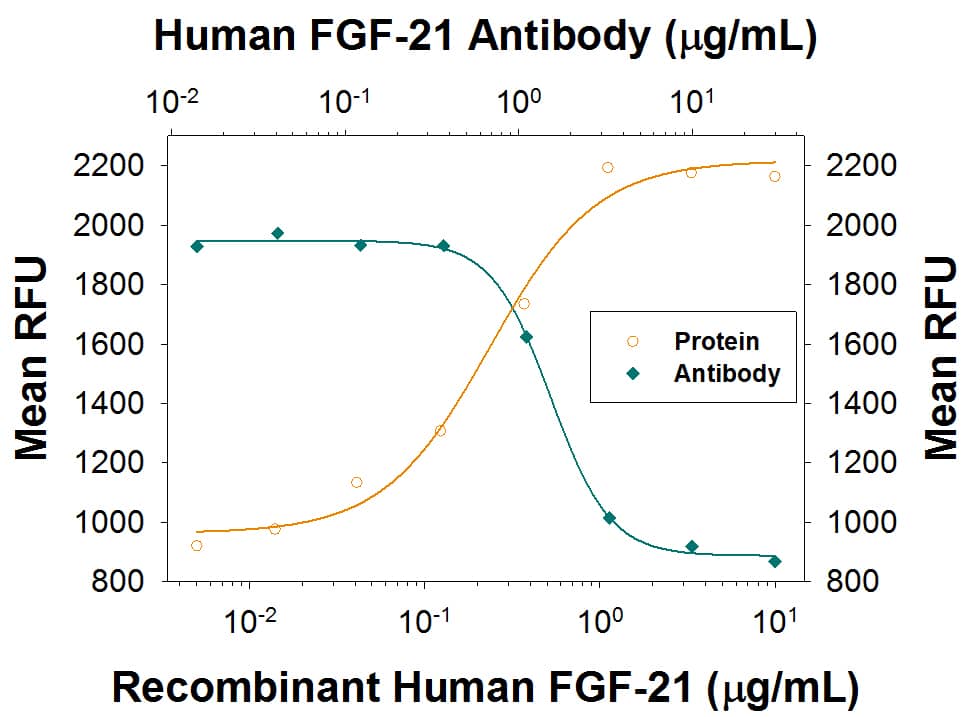Human FGF-21 Antibody
R&D Systems, part of Bio-Techne | Catalog # MAB25373

Key Product Details
Species Reactivity
Applications
Label
Antibody Source
Product Specifications
Immunogen
His29-Ser209
Accession # Q9NSA1
Specificity
Clonality
Host
Isotype
Endotoxin Level
Scientific Data Images for Human FGF-21 Antibody
Cell Proliferation Induced by FGF-21 and Neutralization by Human FGF-21 Antibody.
In the presence of Recombinant Mouse Klotho beta (Catalog # 2619-KB), Recombinant Human FGF-21 (Catalog # 2539-FG) stimulates proliferation in the BaF3 mouse pro-B cell line transfected with human FGF-RIIIc in a dose-dependent manner (orange line). Under these conditions, proliferation elicited by Recombinant Human FGF-21 (500 ng/mL) is neutralized (green line) by increasing concentrations of Goat Anti-Human FGF-21 Mononclonal Antibody (MAB25373). The ND50 is typically 0.5-3 µg/mL.Applications for Human FGF-21 Antibody
Neutralization
Formulation, Preparation, and Storage
Purification
Reconstitution
Formulation
Shipping
Stability & Storage
- 12 months from date of receipt, -20 to -70 °C as supplied.
- 1 month, 2 to 8 °C under sterile conditions after reconstitution.
- 6 months, -20 to -70 °C under sterile conditions after reconstitution.
Background: FGF-21
Fibroblast growth factor 21 (FGF-21) is a member of the FGF gene family, which currently contains 22 human members. Based on its structure, it is further classified as an FGF19 subfamily member. This subfamily includes FGF-19, -21, and -23. Like all other FGF subfamilies, FGF-19 subfamily members contain a 120 amino acid (aa) core FGF domain that exhibits a beta-trefoil structure (1, 2). Unlike other FGF subfamilies, FGF-19 subfamily members apparently exhibit poor binding to ECM, resulting in highly diffusible molecules (3). The c-DNA for FGF-21 predicts a 209 aa polypeptide that contains a 28 aa signal sequence and a 181 aa mature region (4). Notably, FGF-21, as well as FGF-19 show limited binding to heparin (4). One potential alternate splice form has been reported. It shows a 43 aa substitution for the
C-terminal 12 aa of the standard form (5). Mature human FGF-21 shows 81% aa identity to mouse FGF-21, and is known to be active on mouse cells (4, 6).
The FGF-19 subfamily is considered endocrine in nature. All three subfamily members impact some aspect of metabolism, all three are induced by a nuclear receptor heterodimer that includes RXR, and all three utilize Klotho family members for signal transduction (7, 8, 9). FGF-21 is produced by hepatocytes in response to free fatty acid (FFA) stimulation of a PPARa/RXR dimeric complex (3, 7, 10, 11). This situation occurs clinically during starvation, or following the ingestion of a
high-fat/low-carbohydrate diet. Upon FGF-21 secretion, white adipose tissue is induced to release FFAs from triglyceride stores. Once FFAs reach hepatocytes, they are oxidized and reduced to acetyl-CoA. The acetyl-CoA is recombined into 4-carbon ketone bodies (acetoacetate and beta-hydroxybutyrate), released, and transported to peripheral tissues for TCA processing and energy generation (11, 12).
References
- Itoh, N. and D.M. Ornitz (2004) Trends Genet. 20:563.
- Mohammadi, M. et al. (2005) Cytokine Growth Factor Rev. 16:107.
- Huang, X. et al. (2006) Mol. Carcinog. 45:934.
- Nishimura, T. et al. (2000) Biochim. Biophys. Acta 1492:203.
- GenBank Accession #: EAW52401 (2006).
- Ford, A.M. et al. (2005) J. Clin. Invest. 115:1627.
- Moore, D. D. (2007) Science 316:1436.
- Ogawa, Y. et al. (2007) Proc. Natl. Acad. Sci. USA 104:7432.
- Kurosu, H. et. al. (2007) J. Biol. Chem. 282:26687.
- Lundasen, T. et al. (2007) Biochem. Biophys. Res. Commun. 360:437.
- Badman, M.K. et al. (2007) Cell Metab. 5:426.
- Inagaki, T. et al. (2007) Cell Metab. 5:415.
Long Name
Alternate Names
Gene Symbol
UniProt
Additional FGF-21 Products
Product Documents for Human FGF-21 Antibody
Product Specific Notices for Human FGF-21 Antibody
For research use only
